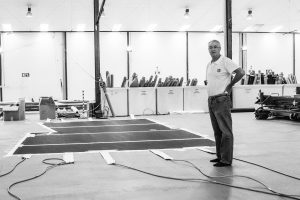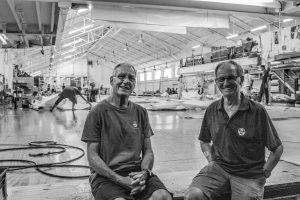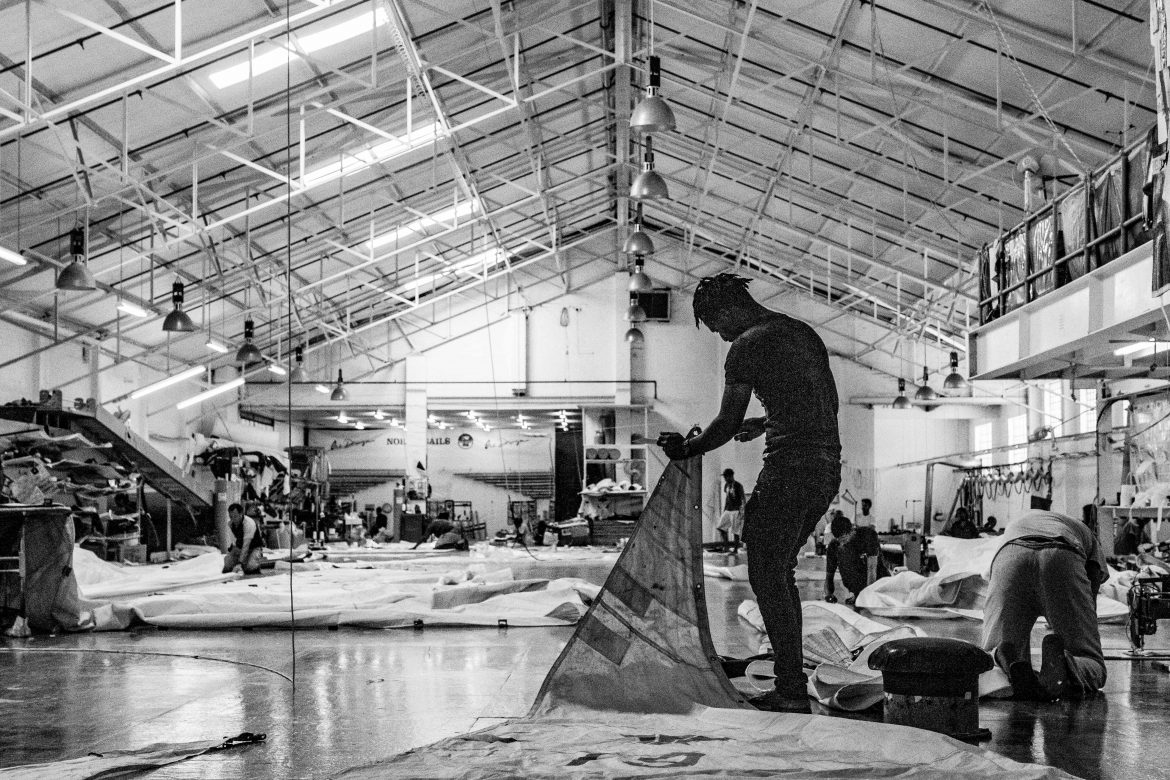For the first time the Lipton Challenge Cup is being sailed on the fast and fun Cape 31’s. The approved sails suppliers for this sports boat are Ullman Sails South Africa and North Sails South Africa.
A mandate of the Cape 31 build is to make use of South African suppliers. Where previously, top-class sailors would largely rely on imported product, the two world-class Cape Town lofts are now exporting state-of-the-art sails, taking on the best in the business. North Sails South Africa and Ullman Sails Production have not only put local sailmaking on the international map, they have also bolstered brand South Africa at a time when local boatbuilders are increasingly making their presence felt on the world stage.
Bobby Jordan spoke to Rick Nankin of North Sails SA, and Tony Strutt and Michael England of Ullman Sails, about their success stories.
Tony Strutt and Michael England, Ullman Sails

Tony Strutt of Ullman Sails
S+L: Can you give a brief historical overview of Ullman in SA?
ME: Ullman Sails South Africa has existed since 2013 when Ullman Sails International (a California-based company dating back to 1967) granted it a sales and manufacturing license to sell sails locally and manufacture for the greater Ullman Group.
S+L: How does the new entity fit into the broader Ullman family?
ME: The new entity is owned by the same investment company that owns Ullman Sails International and is now the primary production facility for all 75 Ullman Sails outlets worldwide. Since both entities are wholly owned by the same company, all key performance criteria like design methodologies, marketing, advertising, public relations, research, development and quality standards can be aligned. Ullman Sails South Africa has become the main partner with its American partner company in driving the expansion of this great brand into the rest of the world.
S+L: Who are Ullman’s major clients and major markets?
ME: Some of Ullman Sails’ custom and production catamaran sails include those built for the likes of Two Oceans Marine, Leopard Catamarans, Nexus Yachts, Balance Catamarans and THL Marine. Our most dominant market outside of South Africa is obviously North America, which is fantastic as this is considered the hardest market to crack. We have great representation in America where the company resides. In fact, Ullman Sails Inc, based in Newport Beach, is the original loft and together with our San Diego loft controls the Southern Californian market, which for us is significant.
S+L: How has the SA industry changed in recent years?
ME: Worldwide the industry has been consolidating around established brand names with a central and dominant manufacturing concern that can manufacture product at competitive pricing. Customers have also become more knowledgeable when it comes to cloth selection and sail construction which is no different here than in the rest of the world.
S+L: Is it fair to say SA is a regional centre of loft excellence?
ME: It depends on what you consider to be regional and we can only talk for ourselves and not our competitors. Regionally our plant has been building sails for more than 35 years and the staff are highly trained in producing sails that are considered excellent enough for luxury and racing boats all over the planet. Ullman Sails South Africa produces the highest quality membrane sail at the most competitive price anywhere in the world. These are sold under our FiberPath brand name and are very highly sought after because they are developed and built in a facility that is globally recognised as excellent.
S+L: Is there a concern about critical skills needed to maintain this?
ME: Yes there is. Ongoing training initiatives internally and externally are continually pursued.
S+L: Future plans: where to from here? Where would you like to position the company over the next decade or so?
ME: In the short term we want Ullman Sails South Africa to further entrench its reputation as a world-class production facility that produces some of the best sails in the world. We want to consolidate our position as manufacturers and sellers of superior-quality sails and once we have done this, we aim to re-assess and determine our growth strategy. From a global perspective Ullman Sails will continue opening facilities worldwide, partnering with other companies that complement ours, conducting research, doing development and improving our product.
S+L: Could SA be doing more to drive brand SA as far as boatbuilding/sailmaking is concerned, or are we more or less on track? What in your opinion could make a positive impact?
ME: SA’s Department of Trade and Industry could certainly do more to drive this industry. Boatbuilding and sailmaking are very well-established industries in South Africa with some of the best products produced by all of the major players. We also have very favourable export conditions. Investment in our local sailors and sailing schools would help. If we had a properly government-funded, international campaign aimed at the Olympics and international sailing, this would help to raise the profile. The future of this industry lies in the youth. They need to be more involved in sailing so that they can become passionate about it and make it a career. We need these youngsters to train so that we can use their energy to innovate.
S+L: The Ullman loft is synonymous with membrane sails. What makes them so popular?
TS: Racing yachts are always looking for a faster, lighter sail that will give them the necessary advantages to win the yacht race. Here the sailor is prepared to invest a lot of money in their new suit of sails that are lighter and faster than the rest. With FiberPath (membrane sails) we can offer a light, but very strong sail that does not stretch or lose shape, and this then converts to more upwind speed. We build more yarns into the corners (head, tack and clew) where sails load up and put in less yarn in the middle of the sail where extra strength is not required.
Rick Nankin, North Sails

Rick Nankin and Geoff Meek of North Sails
S+L: What is the ownership structure?
RN: Internationally the North Group is massive and has recently been purchased by Oakley Capital, a London-based investment company. Here in South Africa, my partners and I own the North Sails business and operate as a franchise within the holding company.
S+L: Tell us a little about the operational side of the business
RN: The business in SA was based on the local market and a huge priority is the service and supply of sails and associated products to local private boat owners and boatbuilders in the country. So, it has always been vital to us to be a manufacturing facility offering world-class sails at really reasonable prices to the local market and not just to sell imported sails locally. Offering a world-class service facility is also key to what happens here at the tip of Africa where many cruising and racing boats sail past, so we believe providing an experienced service team and a large efficient sail loft facility are essential. What has worked for us is to have a good manufacturing base where we supply sails to other North Sails lofts internationally – which is really a huge part of our business – plus the ability to export to private international clients as well, so historically the business is around 70/30 export vs local. For instance, we supply a large quantity of sails to North Sails Caribbean – they are all made here in South Africa apart from moulded sails. That is key to our business and they are our biggest client. In essence, we are a satellite of the big North Sails group, but because we have a big loft we need to be out there finding manufacturing or supply opportunities that exist outside our South African borders. We need to be innovative but we can’t go and do what we want willy-nilly in other areas because territory wise, we are controlled quite tightly by North.
S+L: What is the market locally for North’s famous moulded sails (using 3Di technology)?
RN: We sell moulded sails that are all made in Nevada or Sri Lanka. We design and size them and do all the detailing for our clients, and then feed the information into the production facility through the internal systems on the Net. The sail is then sent to us four weeks later, either shipped here or directly to the yacht. It’s a simple system and works well for us. But the manufacturing base here is the biggest part of our business because there is not a massive market for moulded sails in South Africa.
S+L: What exactly is a moulded sail?
RN: The early 3D sails were called 3DL. They were the first examples of ‘membrane’ or ‘string’ sail technology and were the technology leaders for close to 25 years before North developed their 3Di process. They started producing sails that did not need or have any film, but were rather constructed purely from fibre that was laminated together in an engineered matrix. Without film being used in the process, there is no chance of the delamination or deterioration of film that one sees over time due to UV light in membrane products worldwide. The 3Di process was first used at the company’s plant in Nevada, where dry atmospheric conditions limit moisture absorption in glue. Curvature is built in to a moulded sail as it is constructed, in the same way as moulded composite boats are built. The designed sail shape is fed to the manufacturing moulding system from the North Sails design software and the mould is ‘inflated’ by a network of levers to match the shape required.
S+L: Some South African maritime stakeholders complain about a skills shortage and currency volatility. Do these challenges impact the business?
RN: Because our product is around 60% or 70% exported, the difference between buying and selling again in dollars helps us cover the weak rand. It gives us a slightly better chance of selling at a good price and the extra cost of the cloth in dollars is offset because the whole system is working in dollars. The local costs are mostly wages and overheads, and although the cost of wages has escalated a lot locally, we are still competitive compared with sail lofts from other nations (aside from Asia) at the moment.
Typically, many sailmakers in other parts of the world would start out as young sailors who are working in a loft and are responsible for a sail from start to finish, ie until it ends up in the sail bag. We are doing something similar by involving young sailors who learnt to sail through development sailing programmes like Izivunguvungu in Simon’s Town, the RCYC Sailing Academy at the Royal Cape Yacht Club and the Hout Bay Youth Sailing Development Trust. We now employ young sailors in our design office and service department who take on responsibilities that have grown beyond working in the sailmaking team on the floor.
S+L: How would you describe the current market in SA? How has it changed in recent years?
RN: There’s quite a lot going on currently, but it is more professional and smaller than it was in the heady days when catamarans were selling in massive numbers internationally. Back then a lot of boats were built, some not that well, which resulted in comebacks for our local industry. By comparison, today boats are built on a pretty consistently high-quality basis and many boatbuilders win boat of the year awards at the biggest international boat shows. We supply a lot of high-quality cruising boats going out of here. Not that we don’t supply the lower end of the market, but it is not our big focus.
Visit Cape 31 for more information on the sail specs for this fun, fast sports boat.
Adapted from an article in Sail + Leisure – March 2019
Pictures: Ashleigh de Villiers


